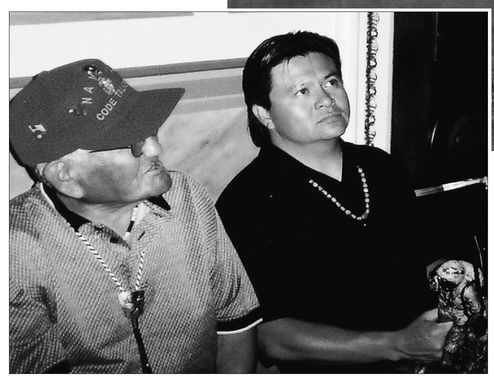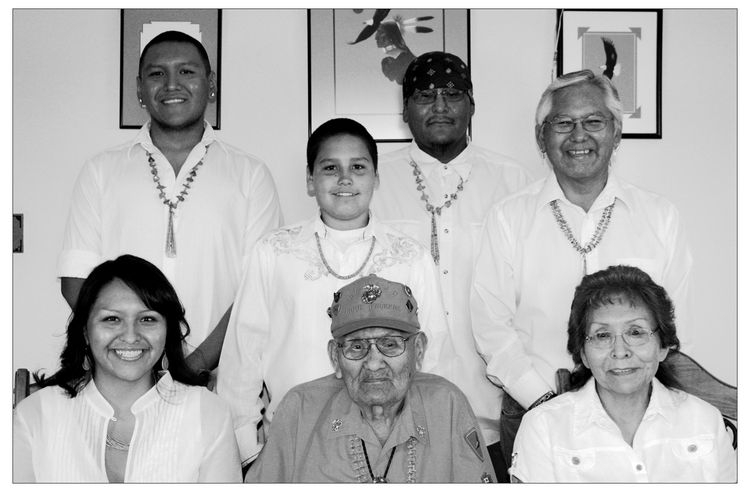Code Talker (42 page)

Imagine that! Blessing the Red Sox and tossing out the game ball.
Courtesy of the Boston Red Sox
Courtesy of the Boston Red Sox

I really liked actor Roger Willie, who starred in
Windtalkers
.
Courtesy of Michael Nez
Windtalkers
.
Courtesy of Michael Nez

My son Mike and me at sister Dora's place
Courtesy of Judith Avila
Courtesy of Judith Avila

(Front row): grandaughter Shawnia Nez Whitfield, me, and Rita Nez (Michael's wife). (Back row): grandson Michael Nez, great-grandson Emery Whitfield, grandson Latham Nez, and son Michael Nez
Courtesy of Michael Nez
Courtesy of Michael Nez
1
Archives.gov
. In 1942, during the early months of the United States' involvement in World War II, the Navajo Reservation covered twenty-five thousand square miles.
. In 1942, during the early months of the United States' involvement in World War II, the Navajo Reservation covered twenty-five thousand square miles.
2
The dive-bombers were designed for descents of sixty degrees from horizontal.
3
Acepilots.com
: The USS
South Dakota,
a battleship that fought in the Battle of Guadalcanal, had a standard displacement of thirty-five thousand tons and a length of 680 feet. It carried a main battery of nine guns arranged in triple turrets. The guns launched sixteen-inch-diameter shells. A secondary battery of sixteen five-inch-diameter guns was fixed amidships.
: The USS
South Dakota,
a battleship that fought in the Battle of Guadalcanal, had a standard displacement of thirty-five thousand tons and a length of 680 feet. It carried a main battery of nine guns arranged in triple turrets. The guns launched sixteen-inch-diameter shells. A secondary battery of sixteen five-inch-diameter guns was fixed amidships.
4
Budweiser was introduced in 1876; Pabst Blue Ribbon in 1893.
5
The “Original Twenty-nine” volunteers were joined by three other Navajo Marines, both in developing the code and in taking it into battle.
6
The history books all say twenty-nine, but I prefer the figure thirty-two since Ross Haskie, Wilson Price, and Felix Yazzie also helped immeasurably in the development of our code. Ross and Felix invaded Guadalcanal with us.
7
Roy is listed as one of the original twenty-nine code talkers, but for some reason, the literature I've read on us does not show him as one of the thirteen landing on Guadalcanal that November. However, he was definitely with us. Our mission was so secret that many records were classified, and after 1968 (when the code was declassified) reports of specific events often depended on fallible memories.
8
AcePilots.com
. World War II Baltimore-class cruisers displaced 13,600 tons, had a length of 673 feet 5 inches, a beam measuring 70 feet 10 inches, a draft of 20 feet 6 inches, and a speed of 33 knots. Armaments consisted of nine guns that launched 8-inch-diameter shells, twelve guns launching 5-inch-diameter shells, forty-eight 40-millimeter antiaircraft guns, and twenty-four smaller, 20-millimeter, antiaircraft guns. They carried two aircraft and a crew of 1,142. (Thanks to Stephen Sherman.)
. World War II Baltimore-class cruisers displaced 13,600 tons, had a length of 673 feet 5 inches, a beam measuring 70 feet 10 inches, a draft of 20 feet 6 inches, and a speed of 33 knots. Armaments consisted of nine guns that launched 8-inch-diameter shells, twelve guns launching 5-inch-diameter shells, forty-eight 40-millimeter antiaircraft guns, and twenty-four smaller, 20-millimeter, antiaircraft guns. They carried two aircraft and a crew of 1,142. (Thanks to Stephen Sherman.)
9
Ibid. The Fletcher-class destroyers displaced 2,100 tons, had a length of 376 feet 3 inches, a beam measuring 39 feet 8 inches, a draft of 13 feet, a speed of 36 knots, and a crew of 273. Armaments were five 5-inch-diameter guns and ten 21-inch-diameter torpedo tubes, as well as eight depth charges.
10
www-cs-faculty.stanford.edu
. Higgins boats were also called LCVPs (Landing Craft, Vehicle, and Personnel). Their length was 36 feet 3 inches, beam 10 feet 10 inches. Displacement, when unloaded, was 18,000 pounds. Speed was 9 knots. They carried two machine guns and could deliver thirty-six fighting men, fully combat-equipped, to shore.
. Higgins boats were also called LCVPs (Landing Craft, Vehicle, and Personnel). Their length was 36 feet 3 inches, beam 10 feet 10 inches. Displacement, when unloaded, was 18,000 pounds. Speed was 9 knots. They carried two machine guns and could deliver thirty-six fighting men, fully combat-equipped, to shore.
11
The names “juniper” and “cedar” are often used interchangeably. Only certain varieties of juniper, with a bluer, more delicate foliage, are actually considered to be a type of cedar (although not a “true cedar,” which is of genus
cedrus
not
juniperus
). Juniper and cedar bark was often used as diapers by the Navajo, after it was rubbed and crushed to soften it.
cedrus
not
juniperus
). Juniper and cedar bark was often used as diapers by the Navajo, after it was rubbed and crushed to soften it.
12
Although it is customary in many Navajo families to address one another by kinship terms (i.e., “my son” or “grandfather”) rather than by given name, when I was a child my family addressed me as
Betoli.
Betoli.
13
Normally, we would milk the goat into a pail and strain the milk through a flour sack, then boil it to pasteurize it. When out with the herd, we sometimes drank the fresh milk as described here.
14
This happened in 1864. Fort Defiance became a boarding school in Arizona, the one I eventually attended. Fort Sumner is located in the Bosque Redondo area of eastern New Mexico.
15
She was approximately thirteen in white men's years.
16
Nathan Aaseng,
Navajo Code Talkers,
p. 7. An estimated two thousand
Diné
died in captivity from disease and hunger.
Navajo Code Talkers,
p. 7. An estimated two thousand
Diné
died in captivity from disease and hunger.
17
Ibid., p. 9. Aaseng mentions this feeling of solidarity.
18
Many Navajos took dry sweat baths, utilizing radiant heat from the hot rocks. However, my family poured water over the rocks to create steam. We also employed the medicinal plants mentioned above in the sweat lodge.
19
Survey Graphic: Magazine of Social Interpretation
23:6 (June, 1934), p. 261. The dam is in Arizona.
23:6 (June, 1934), p. 261. The dam is in Arizona.
20
NPS.com
.
.
21
Frank Waters,
Masked Gods,
pp. 132â133.
Masked Gods,
pp. 132â133.
22
Waters, p. 142.
23
Arizona and New Mexico sheep and cattle interests opposed the expansion of the reservation, and legislators from New Mexico and Arizona fought successfully for the bill's defeat.
24
Father Berard Haile, OFM, wrote a Navajo grammar book published in 1926, the first edition of
A Manual of Navajo Grammar,
but it was known by very few people.
A Manual of Navajo Grammar,
but it was known by very few people.
25
Some sources say that the corporal hit the recruits in the face, but I remember the incident as told above. I felt it was all “in good fun,” while other sources label the incident as evidence of prejudice against us Navajo men.
26
Chevron,
May 16, 1942.
May 16, 1942.
27
Chevron,
July 4, 1942.
July 4, 1942.
28
A couple of missionaries (among them Father Berard Haile) had devised methods of recording Navajo. But in general the language was unwritten.
29
Nathan Aaseng,
Navajo Code Talkers,
p. 18.
Navajo Code Talkers,
p. 18.
31
Francis must have changed his name after the war, as William Yazzie and Balmer Slowtalker did. He is not listed as Francis Tsinajnnie in any of the books about code talkers. It is also possible that he was one of the code talkers whose documentation was lost.
32
A slang word indicating confusion or mistakes:
s
ituation
n
ormal,
a
ll
f
ucked
u
p.
s
ituation
n
ormal,
a
ll
f
ucked
u
p.
33
Deanne Durrett,
Unsung Heroes of World War II,
p. 65.
Unsung Heroes of World War II,
p. 65.
34
Sally McClain,
Navajo Weapon,
p. 176.
Navajo Weapon,
p. 176.
35
Olive-drab.com. In April 1947, twenty-seven Japanese troops were discovered on Peleliu. They had to be convinced that the war was over.
36
E. B. Sledge,
With the Old Breed,
p. 157.
With the Old Breed,
p. 157.
37
Later, when the war was over, some bodyguards revealed their assignments to the Navajos they guarded. I never officially met my bodyguard(s), if, indeed, I had them.
38
Sally McClain,
Navajo Weapon,
pp. 208â209.
Navajo Weapon,
pp. 208â209.
39
Ibid., p. 221.
40
McClain, pp. 221â222.
41
The phrases “put on” and “put up” are both used when referring to a ceremony.
42
Traditionally, an older person accompanied the “patient” when he visited the hand-trembler.
43
We Navajos practice Bad Way ceremonies as remedies for evil and Good Way ceremonies to help to keep people on the Good Way road of life.
44
Clyde Kluckhorn and Dorothea Leighton,
The Navajo,
p. 163. Memorizing a nine-night chant is comparable to memorizing an entire Wagnerian opera, including the orchestral score, all vocal parts, and details of staging and costumes.
The Navajo,
p. 163. Memorizing a nine-night chant is comparable to memorizing an entire Wagnerian opera, including the orchestral score, all vocal parts, and details of staging and costumes.
45
It is said that a person should attend four sings. Some say it is preferred that the sings all be for the same problem, even if the person attending is not the primary patient in all four.
46
Whether or not this restriction was actually observed is questionable.
47
Some families putting on a sing build a ceremonial hogan, separate from the hogan in which the hosting family lives. This was not done in my case.
48
Scalp shooters often employed a rifle rather than a sling.
49
In some areas, clan restrictions may be more complex.
50
A dish resembling cream of wheat.
51
Yá'át'ééh
can be used to mean “hello” or “good-bye.” It can also mean “good”âor “not good” when used with the negative
dooda. Doo shil yá'át'ééh da
means “I do not like” someone or something.
can be used to mean “hello” or “good-bye.” It can also mean “good”âor “not good” when used with the negative
dooda. Doo shil yá'át'ééh da
means “I do not like” someone or something.
52
The songs commemorated fifty ancient Navajo warriors. No one seems to remember whether forty-nine of these warriors were killed in battle, or whether forty-nine survived.
53
I wish that the three additional men who helped develop the codeâFelix Yazzie, Ross Haskie, and Wilson Priceâhad also been awarded gold medals.
Other books
The Unforgiven by Patricia MacDonald
More Stories from My Father's Court by Isaac Bashevis Singer
The Legend of Darklore Manor and Other Tales of Terror by Vargo, Joseph, Iorillo, Joseph
Murder at Jade Cove (Cedar Bay Cozy Mystery Book 2) by Dianne Harman
Still Water by A. M. Johnson
Initium (Nocte Trilogy (2.5)) by Courtney Cole
Vanished Smile by R.A. Scotti
Birrung the Secret Friend by French, Jackie
